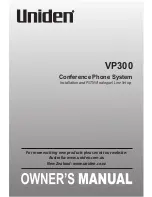
The second four addresses are used by the
codec. The default for the evaluation board and
the software is 530h - no jumpers. The following
table lists the available base addresses (along
with the associated codec address), with a "1"
defined as no shorting jumper and a "0" defined
as a shorting jumper installed:
Base
Codec
X1 X0
Address
Address
1
1
530h
534h
(default)
1
0
604h
608h
0
1
E80h
E84h
0
0
F40h
F44h
INTERRUPT
Although the hardware supports a wide selection
of interrupts, software may have limitations in
the available options. See the SOFTWARE COM-
PATIBILITY section for more information.
The interrupt is set using header J2, also labeled
INT
, (Figure 7) and must also match the software
selected interrupt. The default for the evaluation
board and the software is 7.
DMA SELECTION
Although the hardware supports a wide selection
of DMA channels for playback and capture, soft-
ware may have limitations in the available
options. See the SOFTWARE COMPATIBILITY
section for more information.
The CDB4231 contains two headers for DMA
selection: one determines the playback channel
and the other, if used, determines the capture
channel for full duplex operation. Two shorting
jumpers are needed for the selected DMA chan-
nel, one for the DRQ and one for the DACK.
Header J20, labeled
DMA PLAY
, (Figure 7) is the
primary DMA channel used for both playback
and capture on the CS4248 or CS4231 in SDC
mode, as well as playback on the CS4231 in
full-duplex operation.
Half Duplex - Single DMA Channel
The default configuration for the CDB4231 is
full duplex. When the evaluation board is config-
ured for half duplex, both jumpers on the
DMA
CAPTURE
header J1, (Figure 7) SHOULD BE
REMOVED. Otherwise, contention with other
system resources may occur.
The CS4248 does not contain the second set of
DMA base registers; therefore, it must be oper-
ated in half duplex mode. Since only one DMA
channel is needed at any particular time, the
CS4248 is usually operated in Single DMA
Channel, SDC, mode.
If only one DMA channel is available, the
CS4231 can be programmed for SDC mode
wherein the playback channel, selected on the
DMA PLAY
header is used for both playback and
capture. The default setting for the evaluation
board for the
DMA PLAY
header DRQ3/DACK3.
Full Duplex - Two DMA Channels
Full duplex is only supported on the CS4231
(MODE 2 operation) which contains independent
capture and playback DMA Base registers.
The J1 header, labeled
DMA CAPTURE
, (Fig-
ure 7) is used to support simultaneous capture in
the CS4231 full-duplex mode. The default for
the CDB4231 evaluation board
DMA CAPTURE
header, J1, is DRQ0/DACK0.
To support full-duplex operation, a unique DMA
channel from each header must be selected.
CDB4231/4248
60
DS111DB7
Summary of Contents for CS4231A
Page 63: ...Figure 1 CS4231 Aux1 In CDB4231 4248 DS111DB7 63 ...
Page 64: ...Figure 2 Microphone In Figure 3 Mono Speaker Out CDB4231 4248 64 DS111DB7 ...
Page 65: ...Figure 4 Line In CDROM In Aux2 CDB4231 4248 DS111DB7 65 ...
Page 66: ...Figure 5 Line Headphone Out CDB4231 4248 66 DS111DB7 ...
Page 67: ...Figure 6 Address Decode and Board ID CDB4231 4248 DS111DB7 67 ...
Page 68: ...Figure 7 Analog Power Buffer CDB4231 4248 68 DS111DB7 ...
Page 72: ...Figure 8 Silk Screen CDB4231 4248 72 DS111DB7 ...
Page 73: ...Figure 9 Component Side Top 1st Layer CDB4231 4248 DS111DB7 73 ...
Page 74: ...Figure 10 Solder Side Bottom 4th Layer CDB4231 4248 74 DS111DB7 ...
Page 75: ...Figure 11 Ground 2nd Layer Inverse CDB4231 4248 DS111DB7 75 ...
Page 76: ...Figure 12 Power 3rd Layer Inverse CDB4231 4248 76 DS111DB7 ...
















































